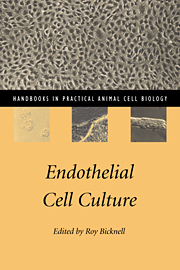Book contents
- Frontmatter
- Contents
- List of Contributors
- Preface to the series
- Acknowledgement
- 1 Introduction to the endothelial cell
- 2 Lung microvascular endothelial cells: defining in vitro models
- 3 Bone marrow endothelium
- 4 Endothelium of the brain
- 5 Isolation, culture and properties of microvessel endothelium from human breast adipose tissue
- 6 Human skin microvascular endothelial cells
- 7 Microvascular endothelium from adipose tissue
- 8 Endothelium of the female reproductive system
- 9 Synovial microvascular endothelial cell isolation and culture
- Index
2 - Lung microvascular endothelial cells: defining in vitro models
Published online by Cambridge University Press: 03 November 2009
- Frontmatter
- Contents
- List of Contributors
- Preface to the series
- Acknowledgement
- 1 Introduction to the endothelial cell
- 2 Lung microvascular endothelial cells: defining in vitro models
- 3 Bone marrow endothelium
- 4 Endothelium of the brain
- 5 Isolation, culture and properties of microvessel endothelium from human breast adipose tissue
- 6 Human skin microvascular endothelial cells
- 7 Microvascular endothelium from adipose tissue
- 8 Endothelium of the female reproductive system
- 9 Synovial microvascular endothelial cell isolation and culture
- Index
Summary
Introduction and application
The tremendous vascular surface area represented by the pulmonary endothelium aids in essential blood/gas exchange but also effectively regulates circulating levels of vasoactive agents. For example, protease activities on the endothelial surface can dictate total blood levels of critical vasoregulatory peptides such as angiotensin converting enzyme (ACE). The continuous capillaries of the lung comprise the majority of this surface area and maintain a highly selective permeability barrier that, when compromised, can lead to oedema and pulmonary pathology.
The microvessels of the lung undoubtedly develop some of their physiological activities from interactions with other pulmonary cells. Information exchange with epithelial type I and type II cells occurs at the level of secreted and extracellular matrix proteins to dictate proper airway architecture and vascular function. It is the understanding at this cellular level that has driven researchers to take the simplistic approach of isolating cell types and culturing them in vitro. But how much information do isolated and repeatedly cultured cells ‘remember’ about how to mimic their functions in situ? If this question is asked frequently by cell and molecular biologists who desire the optimal in vitro model of a vascular bed, our understanding of whole-organ physiology will consequently benefit.
The application of in vitro models of the pulmonary microvasculature must be tempered with defining the cell type as well as the desired physiological measurement. For example, the use of ACE as a reliable marker for pulmonary endothelium was aided by the knowledge that angiotensin could be cleaved when passed through an isolated lung preparation.
- Type
- Chapter
- Information
- Endothelial Cell Culture , pp. 7 - 22Publisher: Cambridge University PressPrint publication year: 1996

